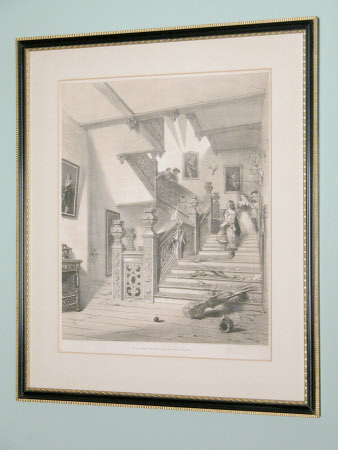Staircase, Aston Hall, Warwickshire
after John Nash (Cardigan 1752 - East Cowes 1835)
Category
Art / Prints
Date
1800 - 1900
Materials
Paper, cardboard, wood and glass
Measurements
530 x 445 mm
Order this imageCollection
Benthall Hall, Shropshire
NT 509651
Summary
Print, engraving, Staircase, Aston Hall, Warwickshire, after John Nash (Cardigan 1752 – East Cowes 1835). Print of the original drawing by J Nash in 1849, illustrating the heavily carved Jacobean staircase at Aston Hall. A dramatic scene, the hall being attacked by cannon fire; figures on the staircase. Glazed in modern black and gilt frame, cream card mount. Inscribed - Staircase Aston Hall Warwickshire (printed). 1800 - 1900. Aston Hall is a Jacobean house in Aston, Birmingham, designed by John Thorpe and built between 1618 and 1635. It is a leading example of the Jacobean prodigy house. The house was severely damaged after an attack by Parliamentary troops in 1643; some of the damage is still evident. There is a hole in the staircase where a cannonball went through a window, an open door and into the banister. The house was built by Sir Thomas Holte and remained in the family until 1817 when it was sold and leased by James Watt Jr. son of industrial pioneer James Watt The house was then purchased in 1858 by a private company (the Aston Hall and Park Company Ltd) for use as a public park and museum. After financial difficulties it was then bought by Birmingham Corporation in 1864 becoming the first historic country house to pass into municipal ownership.
Provenance
Print of engraving by John Nash circa 1800 - 1900. Owned by Sir Arthur Paul Benthall (1902 – 1992). Bequeathed to The National Trust in the will of Sir Arthur Paul Benthall dated 28th July 1983. Accepted for ownership by The National Trust in 1993 following the death of Sir Arthur Paul Benthall in 1992.
Marks and inscriptions
STAIRCASE ASTON HALL WARWICKSHIRE (printed)
Makers and roles
after John Nash (Cardigan 1752 - East Cowes 1835), artist
